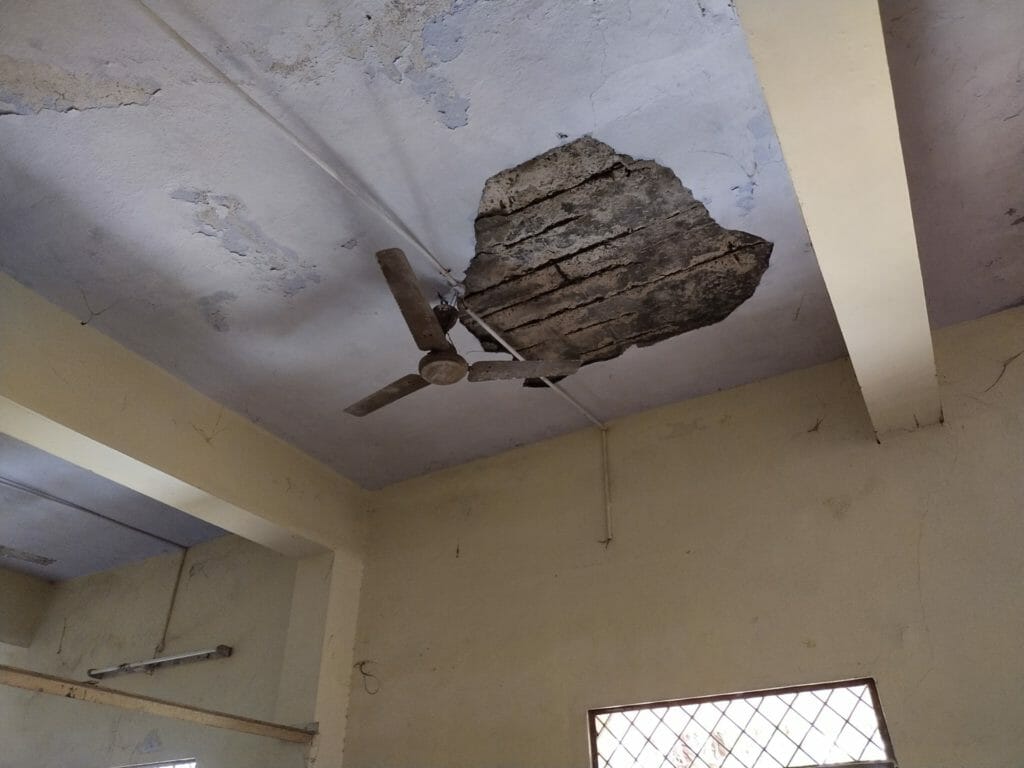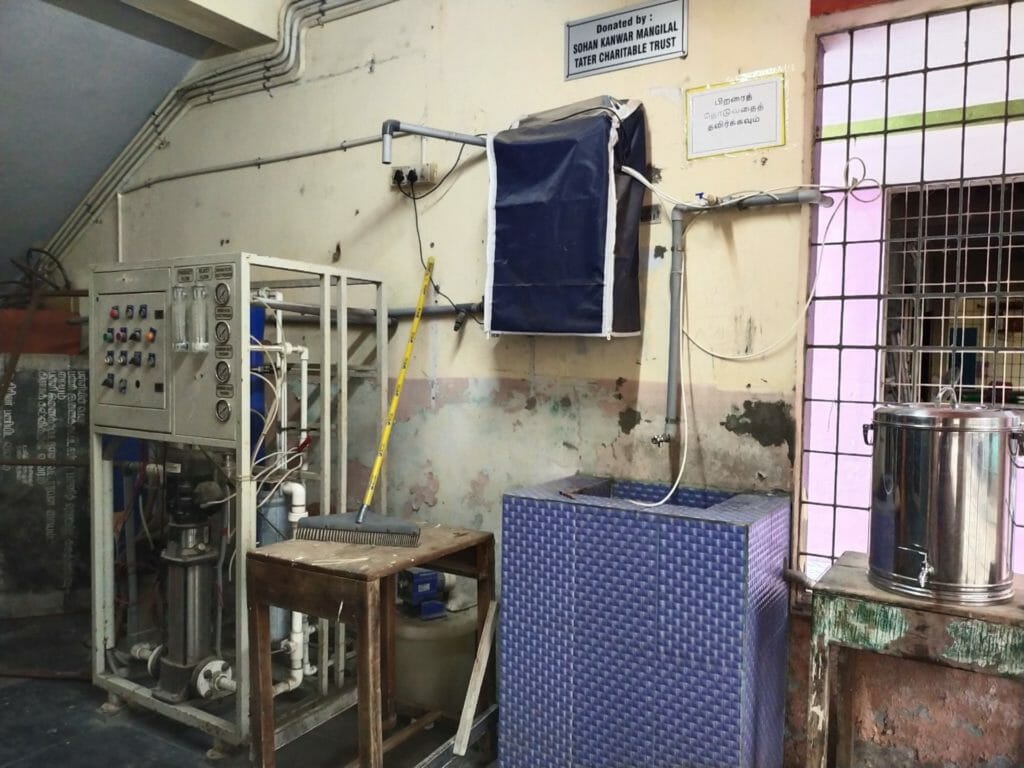With the outbreak of COVID-19 and the subsequent lockdowns, schools in Chennai run by the Greater Chennai Corporation (GCC) saw record high enrolment of new students. Across the 281 schools run by the civic body in the city, the total number of students increased from 90,394 in 2020-21 to 1,13,793 in 2021-2022, a 10-year high in enrolment.
Many of these students moved from private schools to GCC-run schools in the middle of the pandemic. Loss of jobs for parents during the lockdown, the government declaring ‘all pass’ for all class students, and private schools demanding the same fee even for online classes were among the many reasons for students to make the switch.
The influx of students has put a strain on the system. Existing gaps in infrastructure and issues with teacher-student ratios in the civic body-run schools have been magnified by the addition of new students.
Read more: When parents are involved: What we saw in a Chennai government school
Poor physical infrastructure of GCC schools
Lack of adequate physical space and toilet facilities in schools became an even more pressing issue with the increase in enrolment.
A GCC school in Purasaiwalkam has two buildings with around 20 classrooms. The buildings were built in 1991 and 2000 respectively. While minor civic complaints are attended to by the GCC workers once in a while, the buildings have not undergone a full renovation in over three decades.
“During rains, water leaks into classrooms. We cannot make the children sit inside the classroom then. There are insufficient benches in the classrooms, this is tougher to deal with given the increase in the number of students,” said the teachers.
The school had a strength of around 400 students pre-COVID, which increased to 680 in 2021-22 and dropped to 600 in 2022-23.
When K Sathish, now in Class 10, moved from a private school to the GCC-run school in Purasaiwalkam in 2021, he was shocked at the state of the school building. The walls had cracks and there were leakages during rains. The classrooms had insufficient and broken benches. There were five toilets for around 600 students. The auditorium was half-built. The lab did not have enough computers and was not accessible to students.
“Initially when the teachers could not accommodate all the students inside the classroom, they made us sit under the trees, on the ground. Later, they stopped taking classes outside. However, as there were not enough benches, at least five to eight students would have to sit on the floor of the classroom. The whole system was different and I found it difficult to adapt to the changes,” he said.
C Karthikeyan, Sathish’s father, said that he had no option but to move his son from a private school to a GCC-run school during COVID as he lost his job during the lockdown. “My son was very interested in computer courses and sports. Many GCC schools do not have proper basic facilities for both. As soon as I found a job, I borrowed some money and transferred him to his old private school as he was clearly struggling at the Corporation school which did not have many basic amenities,” he said.
Karthikeyan’s experience is shared by others who made the switch as well. Once the lockdown eased, parents who could afford to do so moved their wards back to private schools. According to data from GCC, the student strength dropped to 1,07,743 in the academic year 2022-23, down by around 6,000 students from the previous academic year.
Jagadeesan R was in for a shocker when he admitted his daughter to a GCC-run school in Anna Nagar. He alleged that the school students were prone to anti-social activities. “We could find empty liquor bottles on the school campus. I was concerned about safety and shifted my daughter to a private school as soon as I could,” he added.
Speaking on the lack of toilet facilities, he said that the new toilets were under construction for months now and the existing toilets were used by both male and female students. “The teachers had set up separate break time for boys and girls. However, this became a concern around health and hygiene as well,” he noted.
The teachers in the school said that the toilets were being built under the Central Government’s Nirbhaya Scheme and would soon be functional.

“When a parent comes to the school seeking admissions for their child, the first thing they check is the toilet facility. The facade of the building, the atmosphere, scope for extracurricular activities are all attractive features. While we have struggled to provide basic amenities, the private schools in the locality, which have all these features, have also started providing instalment facilities for parents to pay the fee. This has led to the parents switching their kids to private schools once again,” said a teacher.
Student-teacher ratio suffers
Even when there has been a sudden rise in enrolment of students, most GCC schools have not added more teaching staff. They function with either the same number of teachers as before or in some cases, even fewer, due to retirement or transfers.
At least two government schools in Purasaiwalkam did not have headmasters (HMs). While the HM in a middle school retired in April 2020, an HM of a higher secondary school was transferred recently. Both schools have only an acting HM.
| Academic year | Total number of students | Total number of permanent teachers |
| 2020 – 2021 | 90,394 | 3079 |
| 2021 – 2022 | 1,13,793 | 3046 |
| 2022 – 2023 | 1,07,743 | 2953 |
Data sourced from the Education Department of GCC shows that though the 281 GCC schools in Chennai saw a rise in enrolment of new students, the number of permanent teachers has reduced over the years.
A middle school in Kilpauk had 125 students in 2019-2020. This increased to 212 in 2020-2021 and 312 in 2021-2022. The strength of students fell to 210 in 2022-2023. The entire time, the school has had a maximum of six teachers, one of whom has the additional duty of an HM.
Physical education teachers are appointed only in high schools and higher secondary schools. Teachers in middle schools have to play multiple roles, one of which is also that of a physical education teacher.
The teachers in the school in Kilpaul said that the major challenge was the lack of sufficient staff.
“We had six teachers for 125 students and now we have five teachers for 210 students. We need an HM and at least three more teachers to handle the additional students,” they said.
The teachers added that the GCC has not conducted counselling for the promotion and appointment of teachers in GCC schools since the outbreak of COVID-19.
Poor student-teacher ratio adds pressure on the teaching staff and hampers the quality of education. In addition to teaching duties, the teachers in GCC schools are also tasked with work such as seeking funds from local donors to improve school infrastructure.
“Usually many donors provide RO water purifiers but we have no access for maintenance of the purifiers. The purifier we have broke down back in 2019 and we did not have the Rs 50,000 needed to repair it. After seeking funds to fix it, a resident in the locality donated a new water purifier for the school recently,” said a teacher of the school in Kilpauk.
Teachers in many GCC schools also rely on donors to buy benches, tables, stationery items and notebooks. “We received around 50 benches through a donor recently”, said a teacher in Anna Nagar.
Read more: Teaching during the pandemic: Experiences, challenges and the way ahead
What is the GCC doing to improve the facilities?
In a bid to meet the infrastructural needs due to increased student strength, the GCC made a slew of announcements for the 281 schools in the budget this financial year. This included the allocation of Rs 25 crores for infrastructure improvement across 28 schools under the CITIIS scheme and works are underway for the same.
For routine repairs and maintenance of the school premises all 281 schools have been allocated a total of Rs 92.35 lakhs. This apart, around 231 GCC schools are also likely to get digital infrastructure and modern furniture at the cost of Rs 1,432 crore funded by the European Union and France-based AFD bank.
Futher, Rs 59 lakhs has been earmarked for School Management System and Learning Resources Repository Management System under the CITIIS scheme of Chennai Smart City Limited, and a sum of Rs 2.45 crore for School Leadership Development and Transformation and Rs 35 lakhs for cricket and football coaching.
Such efforts would improve the physical infrastructure of the schools and expand the scope of extracurricular activities.
To tackle the shortage of teaching staff, the GCC has approved the appointment of over 450 temporary teachers through school management committees (SMCs) to Corporation schools, with a salary range of Rs 10,000 to Rs 13,000. A resolution in this regard was passed in the council meeting held in July, said the officials from the education department of GCC.
A free breakfast scheme, in addition to the midday meal scheme, is also set to be launched in the coming months.
While the pandemic brought many students back into the fold of the civic body-run schools, they have struggled to retain the students owing to poor facilities and overburdened teachers. Urgent measures to improve physical infrastructure – with adequate seating, better sanitation facilities, access to clean water, better lab facilities and playgrounds will help make studying in GCC schools an attractive proposition. In addition to this, ensuring the schools are adequately staffed to provide the requisite amount of attention to each student is a challenge that the civic body must address on priority.
COVID-19 has highlighted the importance of having an affordable public school system. The learnings from the past few years have shown what must be done to improve Chennai’s schools.

